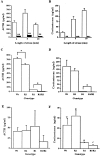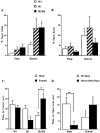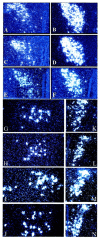Mice deficient for both corticotropin-releasing factor receptor 1 (CRFR1) and CRFR2 have an impaired stress response and display sexually dichotomous anxiety-like behavior
- PMID: 11756502
- PMCID: PMC6757589
- DOI: 10.1523/JNEUROSCI.22-01-00193.2002
Mice deficient for both corticotropin-releasing factor receptor 1 (CRFR1) and CRFR2 have an impaired stress response and display sexually dichotomous anxiety-like behavior
Abstract
Corticotropin-releasing factor (CRF) and its family of peptides are critical coordinators of homeostasis whose actions are mediated through their receptors, CRF receptor 1 (CRFR1) and CRFR2, found throughout the CNS and periphery. The phenotypes of mice deficient in either CRFR1 or CRFR2 demonstrate the critical role these receptors play. CRFR1-mutant mice have an impaired stress response and display decreased anxiety-like behavior, whereas CRFR2-mutant mice are hypersensitive to stress and display increased anxiety-like behavior. To further elucidate the roles of both CRF receptors and determine their interaction in behaviors, we have generated mice deficient in both CRFR1 and CRFR2. The behavioral phenotype of these mice demonstrates a novel role of the mother's genotype on development of pup anxiety. We have found that although the female double-mutant mice display anxiolytic-like behavior, the male double-mutant mice show significantly more anxiety-like behavior compared with the females. We have also determined that the dam's CRFR2 genotype affects the anxiety-like behavior of the male mice, such that a pup born to a heterozygous or mutant dam displays significantly more anxiety-like behavior regardless of that pup's genotype. Double-mutant mice also display an even greater impairment of their hypothalamic-pituitary-adrenal axis response to stress than that of the CRFR1-mutant mice. CRF mRNA levels are elevated in CRFR1- and double-mutant mice, and urocortin III and vasopressin mRNA levels are increased in CRFR2- and double-mutant mice. These results indicate that both CRFR1 and CRFR2 have critical roles in gene regulation and the maintenance of homeostasis in response to stress.
Figures




Similar articles
-
Corticotropin releasing factor receptor 1-deficient mice display decreased anxiety, impaired stress response, and aberrant neuroendocrine development.Neuron. 1998 Jun;20(6):1093-102. doi: 10.1016/s0896-6273(00)80491-2. Neuron. 1998. PMID: 9655498
-
Mice deficient for corticotropin-releasing hormone receptor-2 display anxiety-like behaviour and are hypersensitive to stress.Nat Genet. 2000 Apr;24(4):410-4. doi: 10.1038/74263. Nat Genet. 2000. PMID: 10742108
-
The role of corticotropin-releasing factor receptors in stress and anxiety.Integr Comp Biol. 2002 Jul;42(3):552-5. doi: 10.1093/icb/42.3.552. Integr Comp Biol. 2002. PMID: 21708750
-
CRF and CRF receptors: role in stress responsivity and other behaviors.Annu Rev Pharmacol Toxicol. 2004;44:525-57. doi: 10.1146/annurev.pharmtox.44.101802.121410. Annu Rev Pharmacol Toxicol. 2004. PMID: 14744257 Review.
-
The CRF Family of Neuropeptides and their Receptors - Mediators of the Central Stress Response.Curr Mol Pharmacol. 2018;11(1):4-31. doi: 10.2174/1874467210666170302104053. Curr Mol Pharmacol. 2018. PMID: 28260504 Free PMC article. Review.
Cited by
-
The evaluation of the clinical utility of urocortin 1 and adrenomedullin versus proBNP in systolic heart failure.Anatol J Cardiol. 2017 Mar;17(3):184-190. doi: 10.5152/akd.2014.5793. Epub 2014 Dec 25. Anatol J Cardiol. 2017. PMID: 25868038 Free PMC article.
-
Domestication of farmed fish via the attenuation of stress responses mediated by the hypothalamus-pituitary-inter-renal endocrine axis.Front Endocrinol (Lausanne). 2022 Jul 22;13:923475. doi: 10.3389/fendo.2022.923475. eCollection 2022. Front Endocrinol (Lausanne). 2022. PMID: 35937837 Free PMC article. Review.
-
Sex and exercise interact to alter the expression of anabolic androgenic steroid-induced anxiety-like behaviors in the mouse.Horm Behav. 2014 Jul;66(2):283-97. doi: 10.1016/j.yhbeh.2014.04.008. Epub 2014 Apr 21. Horm Behav. 2014. PMID: 24768711 Free PMC article.
-
Neuroanatomical evidence and a mouse calcitonin gene-related peptide model in line with human functional magnetic resonance imaging data support the involvement of peptidergic Edinger-Westphal nucleus in migraine.Pain. 2024 Dec 1;165(12):2774-2793. doi: 10.1097/j.pain.0000000000003294. Epub 2024 Jun 14. Pain. 2024. PMID: 38875125 Free PMC article.
-
Corticotropin-Releasing Factor Receptor 1 Antagonism Is Ineffective for Women With Posttraumatic Stress Disorder.Biol Psychiatry. 2017 Dec 15;82(12):866-874. doi: 10.1016/j.biopsych.2017.06.024. Epub 2017 Jul 4. Biol Psychiatry. 2017. PMID: 28793974 Free PMC article. Clinical Trial.
References
-
- Allen JP, Allen CF. Amygdalar participation in tonic ACTH secretion in the rat. Neuroendocrinology. 1975;19:115–125. - PubMed
-
- Bale TL, Contarino A, Smith GW, Chan R, Gold LH, Sawchenko PE, Koob GF, Vale WW, Lee KF. Mice deficient for corticotropin-releasing hormone receptor-2 display anxiety-like behaviour and are hypersensitive to stress. Nat Genet. 2000;24:410–414. - PubMed
-
- Beaulieu S, Di Paolo T, Barden N. Control of ACTH secretion by the central nucleus of the amygdala: implication of the serotoninergic system and its relevance to the glucocorticoid delayed negative feedback mechanism. Neuroendocrinology. 1986;44:247–254. - PubMed
-
- Bilezikjian LM, Vale WW. Regulation of ACTH secretion from corticotrophs: the interaction of vasopressin and CRF. Ann NY Acad Sci. 1987;512:85–96. - PubMed
Publication types
MeSH terms
Substances
Grants and funding
LinkOut - more resources
Full Text Sources
Other Literature Sources
Medical
Molecular Biology Databases
